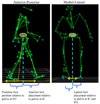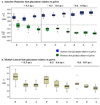Foot placement in a body reference frame during walking and its relationship to hemiparetic walking performance
- PMID: 20193972
- PMCID: PMC2881577
- DOI: 10.1016/j.clinbiomech.2010.02.003
Foot placement in a body reference frame during walking and its relationship to hemiparetic walking performance
Abstract
Background: Foot placement during walking is closely linked to the body position, yet it is typically quantified relative to the other foot. The purpose of this study was to quantify foot placement patterns relative to body post-stroke and investigate its relationship to hemiparetic walking performance.
Methods: Thirty-nine participants with hemiparesis walked on a split-belt treadmill at their self-selected speeds and 20 healthy participants walked at matched slow speeds. Anterior-posterior and medial-lateral foot placements (foot center-of-mass) relative to body (pelvis center-of-mass) quantified stepping in body reference frame. Walking performance was quantified using step length asymmetry ratio, percent of paretic propulsion and paretic weight support.
Findings: Participants with hemiparesis placed their paretic foot further anterior than posterior during walking compared to controls walking at matched slow speeds (P<.05). Participants also placed their paretic foot further lateral relative to pelvis than non-paretic (P<.05). Anterior-posterior asymmetry correlated with step length asymmetry and percent paretic propulsion but some persons revealed differing asymmetry patterns in the translating reference frame. Lateral foot placement asymmetry correlated with paretic weight support (r=.596; P<.001), whereas step widths showed no relation to paretic weight support.
Interpretation: Post-stroke gait is asymmetric when quantifying foot placement in a body reference frame and this asymmetry related to the hemiparetic walking performance and explained motor control mechanisms beyond those explained by step lengths and step widths alone. We suggest that biomechanical analyses quantifying stepping performance in impaired populations should investigate foot placement in a body reference frame.
Copyright (c) 2010 Elsevier Ltd. All rights reserved.
Figures





References
-
- Ayyappa E. Normal human locomotion, Part 1:Basic concepts and terminology. J Prosthet Orthot. 1997;9:10–17.
-
- Bilney B, Morris M, Webster K. Concurrent related validity of the GAITRite walkway system for quantification of the spatial and temporal parameters of gait. Gait Posture. 2003;17(1):68–74. - PubMed
-
- Balasubramanian CK, Bowden MG, Neptune RR, Kautz SA. Relationship between step length asymmetry and walking performance in subjects with chronic hemiparesis. Arch Phys Med Rehabil. 2007;88(1):43–49. - PubMed
-
- Bowden MG, Balasubramanian CK, Neptune RR, Kautz SA. Anterior-posterior ground reaction forces as a measure of paretic leg contribution in hemiparetic walking. Stroke. 2006;37(3):872–876. - PubMed
Publication types
MeSH terms
Grants and funding
LinkOut - more resources
Full Text Sources
Medical

